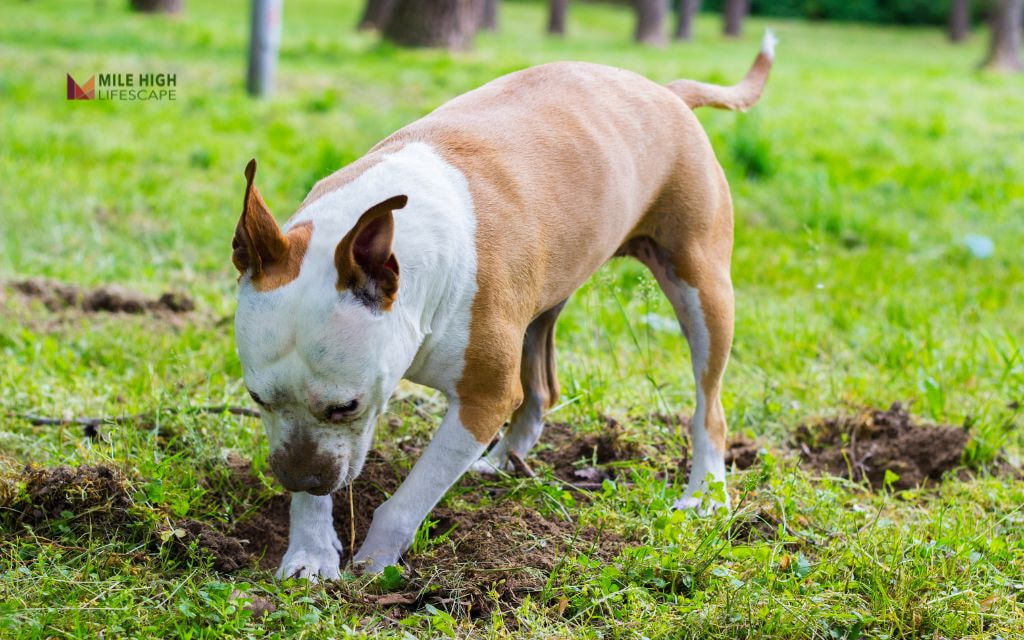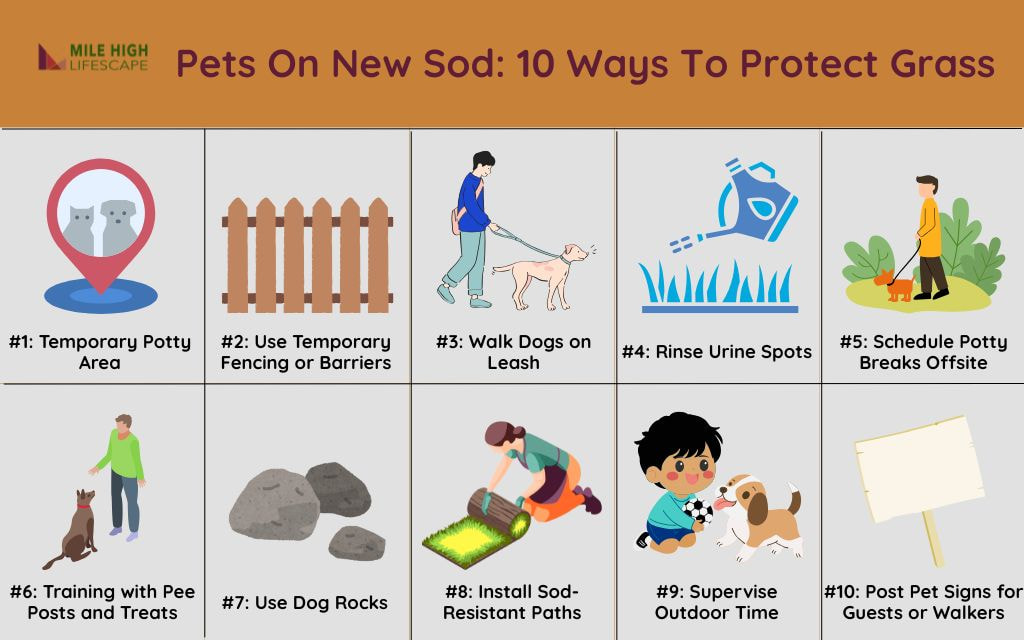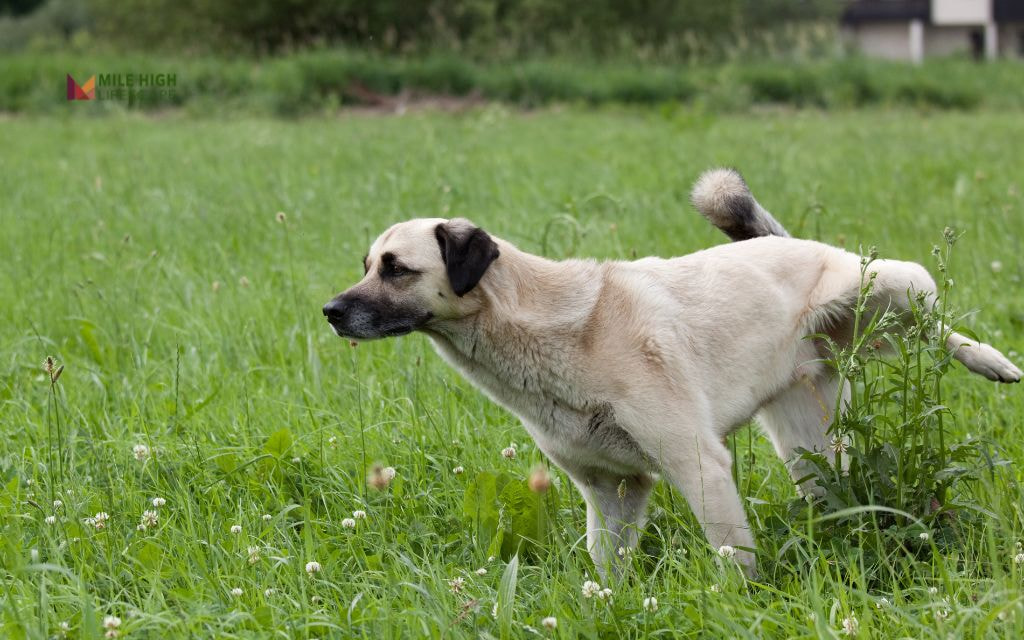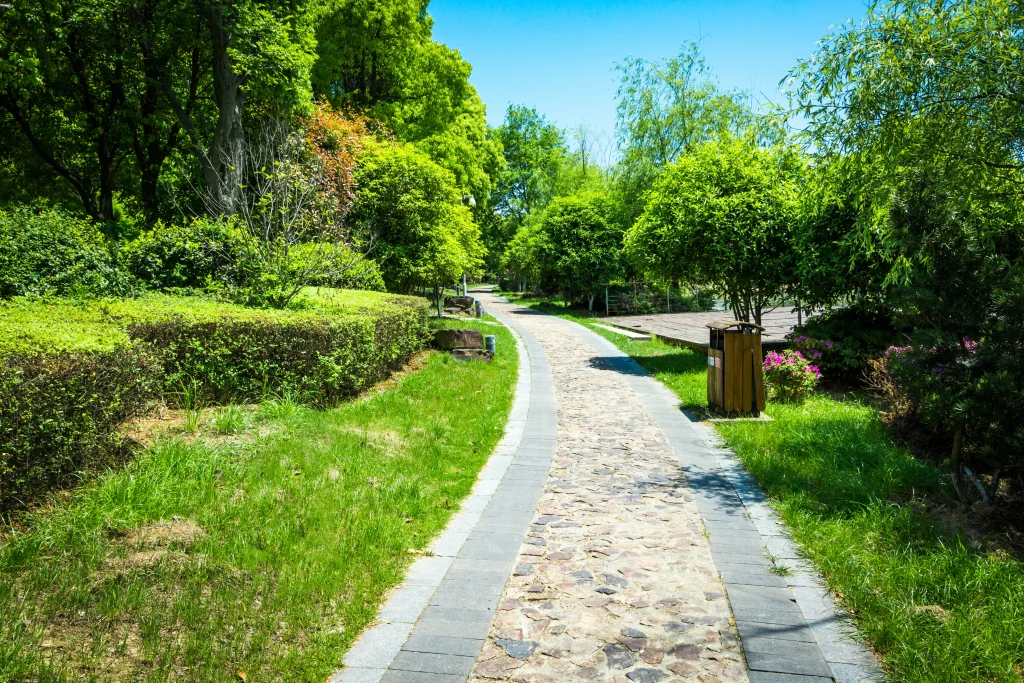“How can I prevent damage from pets on new sod?” New sod requires protection during its critical root establishment period – typically the first few weeks after installation – when young roots remain vulnerable to both pet urine and paw traffic damage.
The challenge becomes clear: pets need outdoor time, but your fresh sod demands protection. At Mile High Lifescape, we’ve helped countless Denver homeowners navigate this exact situation. Success comes through strategic planning and consistent implementation.
This guide provides essential timelines, behavior control methods, damage repair techniques, and Denver-specific recommendations to help you limit the impact from pets on new sod. With the right approach, you’ll establish a resilient lawn while keeping your pets happy.
What Pet Behavior Damages Sod Most – and Why
Urinating
Dog and cat urine contains concentrated nitrogen that creates yellow spots on grass. This “nitrogen burn” happens when urine deposits exceed what grass can process, essentially fertilizing to the point of damage.
New sod, with its developing root system, cannot distribute or process these chemicals effectively, making burn spots more likely and more severe.
Digging
Pets who dig disrupt the crucial seams between sod pieces and tear the developing root mat. This behavior prevents proper root establishment and creates entry points for weeds, pests, and diseases. Even minor digging on new sod can separate sections that haven’t yet grown together, creating permanent weak spots.
Running Paths
Repeated running creates compacted ruts in your lawn, especially during the first weeks after installation when sod hasn’t fully rooted.
Dogs particularly develop “racetracks” along fence lines or between favorite spots, wearing down grass in patterns and preventing root development in those areas.
Rolling or Lying Down
When pets roll or lie on new sod, especially when it’s wet, they flatten the grass and compress the soil. This compression prevents proper air circulation and root expansion.
Since new sod needs space to establish deep roots, this seemingly harmless behavior can create thin, patchy areas.

Top 10 Best Practices to Limit Damage from Pets On New Sod
#1: Set Up a Temporary Potty Area
Create a designated bathroom zone using materials like mulch, gravel, or artificial turf in a corner of your yard. This area becomes your pet’s exclusive bathroom spot during the critical 2-3 week establishment period for your new sod.
Train your pet to use this zone by taking them directly there during potty breaks and offering rewards when they use it correctly.
For male dogs who mark territory, include a vertical element like a small post or decorative hydrant to encourage appropriate marking behavior.
#2: Use Temporary Fencing or Barriers
Install temporary barriers using garden stakes and pet fencing to physically separate pets from new sod areas. These barriers prevent accidental damage during the critical root establishment phase.
For larger yards, create walking paths that allow pets limited access while protecting most of the lawn. Focus protection on areas like sod seams and edges where separation occurs most easily.
In Denver’s climate, consider using snow fencing or other wind-resistant options that withstand our unpredictable weather while keeping pets contained.
#3: Walk Dogs on Leash Only During Sod Establishment
Prevent random roaming and spot marking by walking your dog on a leash in your yard during the establishment period. This controlled approach ensures you guide your pet directly to their designated potty zone and then back inside without detours.
This practice requires commitment but delivers significant results. Create a routine by using the same entry/exit door and following the same path to the potty area each time. The consistency helps your pet understand boundaries while protecting your investment in new sod.
#4: Rinse Urine Spots Immediately
Act quickly by hosing down any urine spots within 10-15 minutes of occurrence. This immediate dilution prevents nitrogen concentration from reaching levels that burn grass. Keep a hose or watering can ready near your door for quick response.
This practice works most effectively when combined with supervision. For working households, consider limiting yard access to times when you can monitor and respond to urination events.
#5: Schedule Potty Breaks Offsite When Possible
Reduce pressure on your new lawn by taking dogs for walks or using non-lawn areas like xeriscaped strips or driveways for potty breaks. This approach decreases the total nitrogen load on your lawn while providing mental stimulation for your pet.

#6: Reinforce Training with Pee Posts and Treats
Install available “pee posts” containing attractive scents to condition your pet’s potty behavior. Place these in your designated bathroom area and consistently reward your pet for using them.
Positive reinforcement creates lasting habits more effectively than punishment. Keep treats near your door for immediate rewards when your pet uses the correct area.
This investment in training during the critical first month pays dividends throughout your lawn’s lifetime by establishing permanent bathroom zones away from your main lawn areas.
#7: Use Dog Rocks or Dietary Additives (Optional)
Consider natural products like Dog Rocks that go in your pet’s water bowl to help reduce nitrogen concentration in urine. While not a complete solution, these products can supplement your overall damage-reduction strategy.
Research pet-safe dietary supplements designed to neutralize urine pH. Consult your veterinarian before implementing any dietary changes, as effectiveness varies by animal.
#8: Install Sod-Resistant Paths or High-Traffic Zones
Create permanent pathways using mulch, decomposed granite, or pavers along fence lines or near doors where pets frequently travel. These hardscaped elements direct traffic patterns and protect vulnerable lawn areas.
In Denver’s climate, consider using local materials like crushed red rock or flagstone that complement our regional aesthetic while providing durable surfaces for pet activity.
#9: Supervise Outdoor Time
Stay outside with your pet during all yard visits for at least the first 2-3 weeks after sod installation. This presence allows you to interrupt and redirect unwanted behavior immediately, preventing damage before it occurs.
#10: Post “Keep Off the Grass” Pet Signs for Guests or Walkers
Install clear signage to prevent neighborhood dogs from urinating on your new sod, especially in front yards or areas near sidewalks. These visual reminders help protect your investment from damage by visiting pets.
Explore more about how to keep dogs off your lawn in this guide.
How to Treat Dog Urine Damage on Sod
When prevention fails and you notice yellow spots appearing on your new lawn, take immediate action with these repair steps:
- Flush the affected area thoroughly with water as soon as possible. This dilutes the nitrogen concentration before it can fully damage the grass roots.
- For established burn spots, apply lawn-specific gypsum or a commercial neutralizer product designed for pet urine damage. These products help restore soil balance and promote recovery.
- For severe damage, trim the burnt grass blades and monitor the area for signs of regrowth from the roots.
- If the roots remain viable, new growth should appear within 7-10 days.
- For completely destroyed patches, you may need to replace small sections with new sod pieces or overseed once the original sod has established.
Products That Help:
- Dog Rocks (place in water bowl)
- Lawn Guard dietary supplements
- Gypsum soil conditioner for spot treatment
Sod and Dog: How to Choose the Right Grass
| Feature | Sod | Seed |
| Time to Use | 2–3 weeks | 6–8 weeks |
| Root Strength | Initially weak | Builds slower, more flexible |
| Recovery Time | Shorter (with care) | Longer |
| Best for Dogs? | Sod (if monitored) | Maybe (if fenced off) |
Local Tip: Fescue and Kentucky Bluegrass blends show superior resilience for Denver-area dog owners. These grass varieties withstand our climate fluctuations while demonstrating better recovery from pet traffic and urine exposure than single-variety lawns.

Long-Term Strategies for a Pet-Friendly Lawn
Once your sod establishes, implement these sustainable approaches for ongoing lawn health:
- Train pets to use specific areas by maintaining their designated bathroom zone. This permanent solution concentrates damage in manageable areas rather than across your entire lawn.
- Create mulched paths around high-traffic edges, especially along fence lines where dogs typically patrol.
- Continue using attractants or deterrents to direct pet behavior. Commercial repellents can protect vulnerable areas while attractants maintain interest in appropriate zones.
- For Denver lawns, perform routine overseeding in spring and fall to maintain density that withstands pet traffic. Thick grass recovers better from occasional damage and resists weed invasion in disturbed areas.
- Design irrigation zones that provide extra water to areas frequented by pets. This additional hydration helps dilute nitrogen and promotes faster recovery from minor damage.
Helpful Tips to Care for Sod When You Have a Dog
Develop a comprehensive maintenance plan that accounts for pet behavior:
- Water early morning (between 4-10am) allows grass to dry before evening pet activities, reducing soil compaction from paw traffic.
- Maintain a higher mowing height of about 3.5 inches to develop deeper roots and increase resilience against pet damage.
- Apply soil conditioners in pet-prone zones quarterly to break down urine compounds and improve soil structure. Products containing humic acid work particularly well in Denver’s alkaline soils.
- Switch to low-nitrogen, slow-release fertilizers once sod establishes (after 3-4 weeks). This approach provides necessary nutrients without compounding nitrogen from pet urine. Explore ways to fertilize new sod properly in this blog.
- Install protective barriers around sprinkler heads and valve boxes where pets might dig. These components attract curious pets and require extra protection to maintain your irrigation system.
Learn to take care of new sod in this helful guide.
Conclusion
You can absolutely have both a thriving lawn and happy pets with proper planning and consistent management. The first 30 days after sod installation require the most vigilance, but establishing good habits during this period creates lasting benefits.
Mile High Lifescape offers pet-friendly sod installation services specifically designed for Denver lawns and the unique challenges of our climate. Our experience with local soil conditions, water restrictions, and pet-friendly landscaping ensures your lawn thrives despite the challenges.
Frequently Asked Questions (FAQs)
How long should I keep pets off new sod?
We recommend keeping pets completely off new sod for the first 7-10 days after installation. After this initial period, introduce limited, supervised access for 2-3 weeks before allowing normal activity. Denver’s climate may extend these timeframes during winter installations when root establishment occurs more slowly.
Will dogs ruin new sod?
Without proper management, dogs can damage new sod through urine burns, digging, and creating traffic patterns. However, with strategic planning and the preventive measures outlined above, your sod can establish successfully even with pets present.
Is sod pet-friendly?
Certain sod varieties offer better pet resistance than others. Consider Bermuda grass, Zoysia grass, perennial ryegrass, or tall fescue when choosing sod for your pet-friendly landscape. In Denver’s climate, fescue/bluegrass blends provide the best balance of pet tolerance and climate adaptation.
How do I keep animals off my new sod?
The most effective approach combines physical barriers (temporary fencing), behavioral training (designated potty areas), and consistent supervision. For wild animals, consider motion-activated sprinklers or natural repellents appropriate to the specific wildlife in your area.
What is the best sod for pets?
For Denver pet owners, we recommend premium fescue/bluegrass blends that withstand both our climate challenges and pet activity. These blends recover more quickly from damage and demonstrate better resistance to urine burns than pure Kentucky bluegrass or ryegrass varieties.
